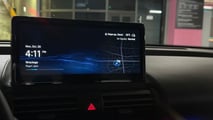
Reviewing a forbidden fruit car, especially one as charming as the Hyundai Inster, is a bit like having a long-distance crush. When you’re not in touch every day, it’s easy to see past the flaws (in this case, dreadfully sluggish acceleration, too many beeps) and focus on the good parts (in this case, so much circular cuteness, so much compelling tech for the price.)
These were my thoughts after spending a day with the adorable Inster on the streets in and around Seoul at the end of October. At 150.6 inches, it’s notably shorter than the Ioniq 5 (182.5 in) or the Kia EV3 (170 in), giving the hatchback a real “built for Asian and European cities” feel. It is a delightful, imperfect city EV that will understandably, but sadly, not be sold in the U.S. Instead, Hyundai will sell the new Inster in Europe and other, luckier global markets. In South Korea, where an ICE-powered version called Casper already exists, the EV will be called the Casper Electric. Knowing that there wasn’t the chance of a long-term commitment, I simply enjoyed my one-day driving affair with the Inster.
Gallery: Hyundai Inster First Drive







What Is It?
The Inster certainly is a deal. Starting at 29.9 million Korean won (about $20,500) it’s about, at current exchange rates, $12,500 cheaper than a Hyundai Ioniq 5—which, with options and better specs, can go quite a bit higher. This is Hyundai’s bargain EV, and it brings a lot to the table while still being a cheap date.
On balance, the car made a charming first impression. The exterior’s many rounded bits – happy-looking head- and taillamps, the outside of the pixel-inspired, four-spoke, 17-inch alloy wheels – meshed well with the EV’s square, chunky accents like the pixel-graphic LED turn signals and the negative space on those wheels. A black circuit board front grille, rear skid plate, and available two-tone paint job come together in a well-proportioned A-segment sub-compact body that’s another in Hyundai’s winning design streak.

What's It Like Inside?
The Inster’s looks invited me into an interior that was more spacious than expected. Its city-car size hides how the long wheelbase design provides decent rear seat room (in Korean spec, up to 38 inches, or 95.8 cm.), and it’s open up front, too. Hyundai used a bench-like front seat, minimized the storage compartment up front and installed a compact console in the dash to create an easy-access tunnel to the passenger-side door if you’re parked alongside a busy road and want to exit street-side. I’m not the smallest human, but this space was indeed easy to get through.
Two 10.25-inch screens – an infotainment unit and the driver display – focus attention on the car’s many features. Specific safety and convenience features will vary by country and region, but the list of available technologies is longer than some city EV buyers might expect. They include forward collision-avoidance assist, blind-spot collision avoidance assist, driver attention warning to prevent jaydriving and smart cruise control with Stop & Go. The interior lights can be displayed in one of 64 colors. There are heated and cooled front seats, Digital Key 2 and a driver-only HVAC setting to conserve energy.

In other words, the Inster has pretty much all the creature comforts you could want in a lower-cost EV, other than maybe motorized seats and wireless AndroidAuto or CarPlay (phone mirroring works when wired). Wireless phone charging and USB-C plugs are standard. Even through the on-screen menus showed some Korean, it felt familiar to recent Hyundai vehicles with Hyundai’s older infotainment system (hence the lack of wireless phone mirroring). The Inster’s system also shares some components with the Casper.
Changes in the car’s built-in navigation system surprised me in a good way like someone bringing just the perfect chocolates to a first meeting. Even when I couldn’t read the signs, color-coded lanes on Korea’s highway system were matched perfectly by the images on the screen, making it near fool-proof to get off at the right exit. The system also offers over-the-air navigation updates.

How Does It Drive?
The date wasn’t all rainbow and roses. The Inster’s main downside is its meager acceleration. Even in sport mode and with the N-like “Drive Mode” button on the steering wheel engaged, there’s little oomph when starting from a stop. Highway passing, zipping from like 40 mph to 60-70, is much better. Two motors are available in the Inster, a 97-kW unit that provides a 0-100 km/h (62 mph) time of 11.7 seconds in the Standard Model and a 115-kW version that does the move in 10.6 seconds in the Long Range model. I drove the Long Range model, but even that was woefully insufficient.
The front-wheel drive set-up provided plenty of nimbleness with direct steering and the EV’s solid balance. The suspension system (McPherson front struts, coupled torsion beam axle-type struts in the rear) was never overly challenged on Seoul’s excellent roads. Still, the Inster is not as satisfying of a ride as, say, the Ioniq 5, which uses Hyundai’s E-GMP platform. Instead, the Inster uses the subcompact K1 platform, which was introduced in 2017 and is otherwise used for gas-powered vehicles (like, say, the original Casper). Even so, the Inster drives quiet. Hyundai’s excellent, five-level i-Pedal adjustable regenerative braking set-up returns and I found myself using the harshest setting more often than not to avoid pressing down too many times on the soft-ish brake pedal. For daily city driving, it’d be my default, and those drives would be mostly enjoyable.

What's Its Range And How Fast Does It Charge?
As for range and charging, the Inster isn’t setting any benchmarks. Still, the 30-minute 10-80 percent charge time using a 120 kW fast charger on the 49 kWh battery and a full-charge range of 221 miles (355 km, using the WLTP scale) is plenty for urban daily driving. Unfortunately, those numbers are only for the Long-Range model with 15-inch wheels. The Standard Range version will “exceed” 186 miles (300 km), Hyundai estimates, from a 42 kWh pack and will provide similar charging times. The Inster also has an 11 kW on-board charger and off-board power options. Someday, we’ll wonder why every EV doesn’t provide this, but at least the Inster joins the growing herd of plug-in vehicles that can also “plug out” with external and internal V2L (vehicle-to-load) ports.
For anyone looking for a more serious relationship with the Inster, Hyundai will offer a slew of dealer accessories for customization. Think airplane-like seat rear table trays, a rear-seat umbrella stand and upper door trim garnish options like photo holders or storage nets.
Early Verdict
I’m a Chevy Bolt driver, so I know EVs like the Inster make perfect daily driving machines. Our short engagement taught me that the cute Inster has a lot going for it. Europeans will take full advantage.
There’s rarely been a more difficult time to predict future automotive sales, and it’s easy to see the logic in Hyundai’s decision to keep the U.S. from the Inster. In an exciting future where the revamped Chevy Bolt EUV turns out to be a hit, there’s a chance I’ll get my chance at a real Inster relationship. For now, I’m happy to know it’ll make someone else very happy.
Sebastian Blanco is a freelance automotive writer and the editor of SAE’s Automotive Engineering magazine. There might be a Pearl Jam easter egg in his review photos.







